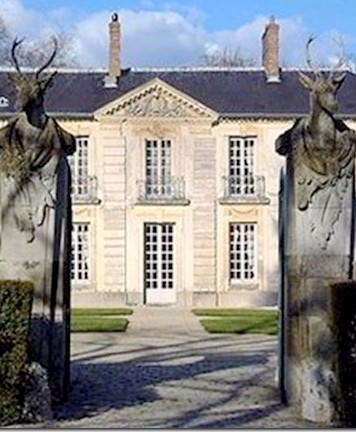During a Virtual Tour of Moffett Road

The Carolyn Morse Ely House, Le Lanterne, by David Adler

By Megan McKinney
Several weeks ago we accepted an invitation from the Lake Bluff History Museum to take a virtual stroll along Green Bay Road to experience the handsome estates built there during the early 20th century. The simulated outing was one of the museum’s Walking Tours, which may be downloaded without charge from Google Play or Apple’s App Store.
As explained then, the series was produced by the Lake Bluff History Museum and the Lake Bluff 125 Committee, with support from The Abbott Fund, to celebrate the 125th anniversary of the village. Within the Walking Tours are Estates tours, which we knew would be perfect for Classic Chicago readers. The Green Bay Road tour proved so popular we decided to take another Estates tour, this time it is a visit to Moffett Road accompanied by the voice of narrator Lise Dominique.

Moffett Road’s Carolyn Morse Ely House, Le Lanterne, above, is one of several of Lake Bluff’s David Adler treasures. We found both Mrs. Ely and Le Lanterne so intriguing that they have become the focus of this article.

In designing Le Lanterne, David Adler referred closely to a great house of the same name in le Parc de Versailles outside Paris. See above for the similarity.

A special delight of the Estates tours coverage of Le Lanterne and other Lake Bluff properties is the personal information readers are given about estate owners. In this case we’ve added a bit, but the basics were there. Carolyn Morse was an iron ore and steel heiress from Marquette, Michigan, who married an Arthur Ely in 1888; their son, Jay Morse Ely, was born the following year. The Elys lived for a time at 297 Ontario Street before moving to the now famous House of Seven Gables in Wheaton, designed by architect Jarvis Hunt in 1897.

Following their divorce “in the early 1900’s,” Carolyn apparently looked forward to a happy single life of active entertaining. She sold the Wheaton house and purchased 17 acres of William H. Ferry’s property along Moffett Road and began conferring with David Adler about creating a stately home “designed for a woman living alone with many servants” in a house with many “very formal spaces for entertaining.” Adler’s sister, the superb interior designer Frances Elkins, was the perfect professional to enter into this collaboration.
The Lake Bluff History Museum segment of Moffett Road tour featuring Le Lanterne, begins with a layout showing the plan for the house and its exquisite outbuildings.

The now four David Adler designed smaller buildings, renovated periodically by various owners, have evolved into charming separate residences.

The first glimpse a visitor has of Mrs. Ely’s estate is of two gate houses, which face each other at its entrance. Above is the North Gate House, with the South Gate House below

The Gate Houses were built in 1916 and Mrs. Ely lived in one of these until the 1922 completion of the estate’s main house, which had been delayed by World War I.
The Orangerie was the focal point of Le Lanterne’s elaborate gardens.

The North Wing of Le Lanterne was detached and relocated west on the lawn of the estate.

Although the interiors are not included in a Walking Tour, this wonderful property has been sold several times since Mrs. Ely’s ownership; therefore it is possible to find photography.

Carolyn Ely did not remain in the house long; she left in 1928 for a marvelous David Adler-designed apartment in 1301 Astor Street.
Edited by Amanda K. O’Brien
Photo Credits: Lake Bluff History Museum







